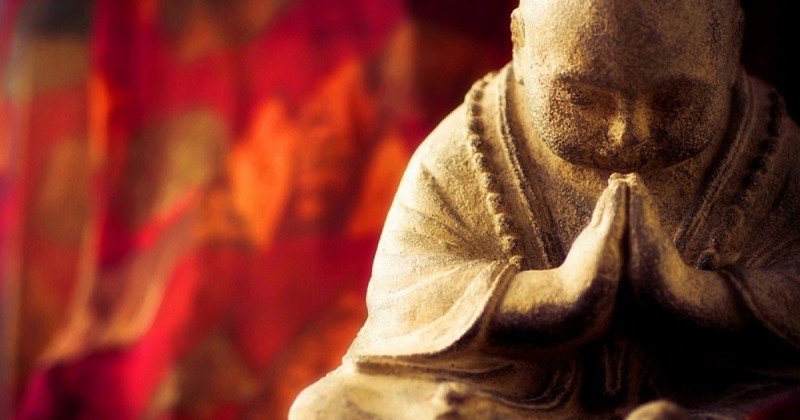’Namaste’: what exactly does it mean?

What does 'Namaste', so often used in meditation, mean? Today we delve into Buddhist philosophy.
If you have the privilege of being a person deep into the world of relaxation and practice some disciplines such as yoga, you might have noticed that instructors often use an intriguing word: Namaste.
Likewise, it is also very common that you have heard on occasion the same term in certain environments of deepening in the spiritual and in certain cultures of Asia. But what is the meaning of this word?
What does the word 'Namaste' mean?
Namaste (you can also find it written as 'Námaste', with accent on the 'a') is a term that comes from the Sanskrit language (the classical language of the India), and its meaning is unknown to most people precisely because of that: the term Namaste originates in lands far away from any Spanish-speaking region.
So, in today's text we will take care of discovering the history and applications of this beautiful word.
The origin of Namaste
The etymological roots of the word Namaste are found in the atavistic Hindu culture Hindu culture. One of the many languages that were spoken in Indian and Nepalese geography is the Sanskritwhich is considered a sacred language for the practitioners of Hinduism.
The term Namasteis used as a traditional form of greeting, both in a moment of meeting and in farewells, and it is usually done with the gesture of joining palms together. gesture of joining the palms of the hands in front of the chest when it is pronounced (a gesture called "Namaste"). (a gesture that is called mudra). It is also used to say thank you or to ask for something, and always as an unequivocal sign of respect towards the interlocutor.
The meaning of Namaste
The etymology of the word Namaste reveals that there are two roots that make up the term. The first of them, namasis a neuter noun that means something like 'greeting', 'reverence' or 'courtesy', and is a particle derived from the root namwhose meaning is: 'to bow' or 'to reverence'.
The second root of Namaste is constituted by the pronoun tewhich is the second person singular of the indirect complement: "to you". For this reason, an accurate translation, etymologically speaking, of Namaste could be: 'I salute you', or 'I bow to you'.
Nowadays, the Hindi language and many of its dialects use the term regularly, being one of the many ways of greeting or saying goodbye to someone.
- We invite you to read this article: "20 wise phrases to reflect on life".
Spirituality, yoga and Namaste
- First of all: if you don't know yet the psychological benefits of yogawe invite you to discover them by reading this article.
Being the meaning of Namaste something so concrete, why is it so often used in the Eastern disciplines of relaxation and meditation?
The spiritual and philosophical meaning of Sanskrit gives Namaste an aspect that goes beyond its purely semantic definition. Buddhism incorporates this word into its spiritual tradition.
According to experts, the particle 'namas' can acquire the meaning of "nothing of me"This means that the ego of the person who utters the term is reduced to nothing, which is a sign of absolute humility with respect to the interlocutor. When the Namaste greeting is made from the authenticity of the soul, it counts, a genuine bond is created between the two people, beyond interests, expectations and social roles..
Divine Essence: Buddhism and purification of the soul
Another interesting feature of the spiritual significance of this word lies in the belief that there is a divine essence in each person. there is a divine essence in each person. Therefore, according to the religious traditions in which this term is rooted, by saying the word Namaste while accompanied by the mudra (hands joined in prayer position and a slight forward leaning of the trunk, whose cultural significance stems from Eastern religions), we are attesting to the presence of the essence of God in oneself and in the other person. The divine essences recognize and greet each other.
Although in yoga sessions Namaste is often used as a farewell, at the end of the class, the truth is that it is more a greeting than a way of saying goodbye. In fact, it is more of a greeting than a way of saying goodbye, practitioners of the Eastern disciplines of self-knowledge recommend that Namaste be used in the introduction and the first exercises of each session, as a mantra. mantra (although there is no reason based on scientific method why the word Namaste should be used in one context and not another). This expression is often used in the Western world as a way of expressing good wishes to others.
However, yoga teachers prefer to use the mantra at the end of the class, since that is the time when the environment and the psyche of each student is in a situation most likely to benefit from Namaste.
The secular use of this term
Of course, it is not necessary to believe in the Buddhist faith to use this term. However, it should be kept in mind that since the practice of many forms of meditation often takes place in environments associated with Buddhism, it can be an element that contributes to the ambience of the sessions and to increase their suggestive power.
It should not be forgotten that in tasks related to the regulation of attentional focus, aspects associated with the aspects associated with suggestion are very important, so it is worth taking advantage of its potential to achieve the desired effect and facilitate the work of those who participate in these experiences.
Bibliographical references:
- Borges, Jorge Luis with Alicia Jurado (1976), What is Buddhism. 2000. Madrid: Alianza Editorial.
- Gethin, Rupert (1998). The Foundations of Buddhism. Oxford University Press.
(Updated at Apr 13 / 2024)